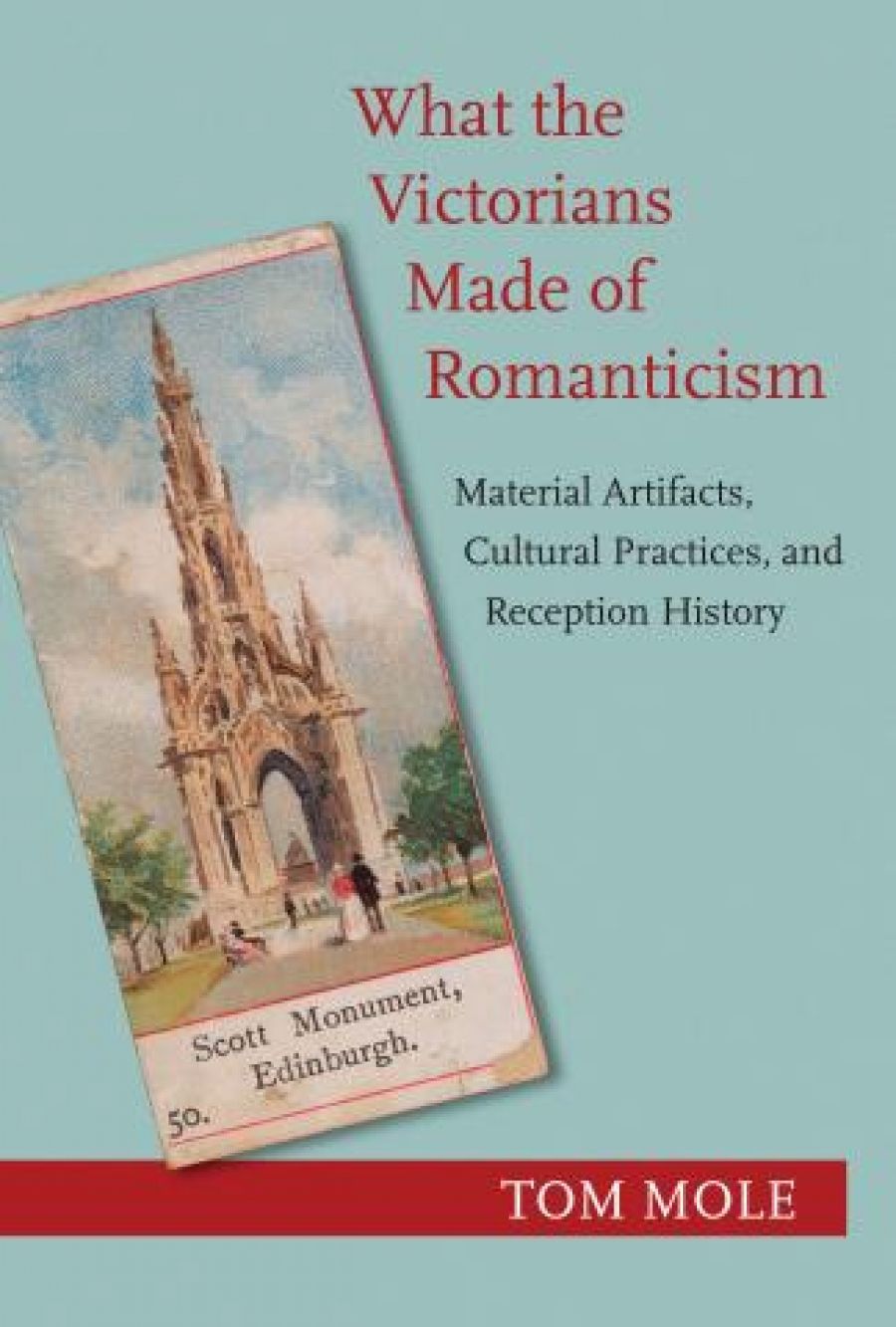
- Free Article: No
- Contents Category: Literary Studies
- Custom Article Title: Michael Falk reviews 'What the Victorians made of Romanticism: Material artifacts, cultural practices, and reception history' by Tom Mole
- Custom Highlight Text:
A quiet revolution is underway in academic literary criticism. Three movements are at the vanguard: ecocriticism, digital humanities, and material culture. At first, they might seem distinct. Ecocritics see literature as a response to the environment. Digital humanists see literature as a repository of machine-readable data ...
- Book 1 Title: What the Victorians made of Romanticism
- Book 1 Subtitle: Material artifacts, cultural practices, and reception history
- Book 1 Biblio: Princeton University Press (Footprint), $79 hb, 329 pp, 9780691175362
The new scholars could not disagree more. If an ecocritic sees the word ‘tree’ in a poem, they see a live or dead tree, in a live or dead ecosystem, whose existence is determined by immutable physical laws as much as by ideology. For a digital humanist, the word ‘tree’ is a string of four characters – t, r, e, e – that can be counted, measured, mapped, or charted. For a material culture scholar, ‘tree’ is four physical ink-marks on a page, ink-marks a person can hold, see, smell, buy, find, lose, or ‘remediate’: for example, by quoting the text on a decorated saucer or tattooing it attractively on a forearm. We are in the grips of a ‘material turn’ in literary and cultural studies, and the early results are exciting.
Tom Mole’s new book is a fine contribution to this turn. Indeed it is quite an eccentric and original contribution. It is a study of Lord Byron, Percy Shelley, Felicia Hemans, William Wordsworth, and Walter Scott; or rather, it is a study of Victorian-era sermons, illustrations, statues, picture postcards, and anthologies that quote or refer to them. In some ways, it is an old-fashioned reception study, about how later generations responded to earlier writers. But Mole’s analysis of material culture and use of digital techniques lead him down some intriguing rabbit holes.
A classic reception study might describe how Matthew Arnold turned to the Romantics as an alternative to religion, or how Elizabeth Barrett Browning crept out of Hemans’s shadow. In Mole’s book, we instead meet Charles Haddon Spurgeon, the Baptist preacher most famous today for declaring that ‘there are difficulties in everything, except in eating pancakes’, and we learn how he misquoted Byron to his huge and adoring congregations. One Sunday, Spurgeon would lambast the atheistical poet for his ‘folly’. Next Sunday he would approvingly quote Byron’s lines on the ‘music of the spheres’, apparently unaware he was quoting the raciest of all poems, Don Juan. Bits of text fly through society, and can find an audience in unexpected quarters.
Another familiar story is the rise of the canon. We know how nineteenth-century critics and schoolteachers selected a curriculum of texts to impart to their students. Indeed, we have spent much of the last forty years trying to break their selection apart. Mole turfs the curriculum out the window, and discusses statues and postcards instead. The French Revolutionists had promoted the idea of a secular ‘pantheon’, but of course moderate Victorians were frightened of anything that smacked of Robespierre. Instead of building a central structure to house all their worthies, the Victorians constructed a ‘distributed pantheon’ of statues and monuments all over the country, stretching from the Scott Monument in Edinburgh to the statues of Byron in Cambridge and Hyde Park.
Every statue was controversial. Mole is a precise writer, and navigates thorny politics with ease, for instance when he describes the frequent attempts to have Byron recognised in Westminster Abbey. Every monument was also part of the complex ‘web of reception’. Mole’s attractive maps show how monuments were amusingly juxtaposed in city streets and squares. The Tory Sir Walter Scott was immortalised just up the road from the radical Political Martyrs. The postcards Mole has collected show how these monuments thrust literature into people’s everyday lives. In July 1900, ‘Dearest Aunt’ received a card describing her niece’s trip to Portobello, near Edinburgh. The picture of the Scott Monument also informed her that the novelist was ‘The Wizard of the North’ and died in 1832, facts she was surely thrilled to discover.
What Mole shows is that literature is neither monolithic nor well behaved. It whizzes about the world in a bewildering variety of forms. Teachers, critics, priests, and politicians might try to shape how people read it, but really the ‘media ecology’ is beyond their control.
Two hundred years ago, Schopenhauer claimed that ‘the world is my representation’. A century earlier, Descartes doubted everything except the existence of his own thinking self. Mole and writers like him are slowly reversing such attitudes. Reality is no longer only in the mind, and it is all the more mysterious and exciting for that.


Comments powered by CComment